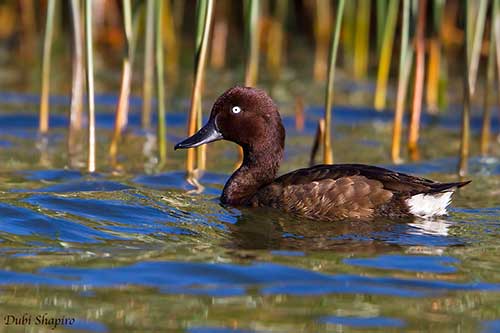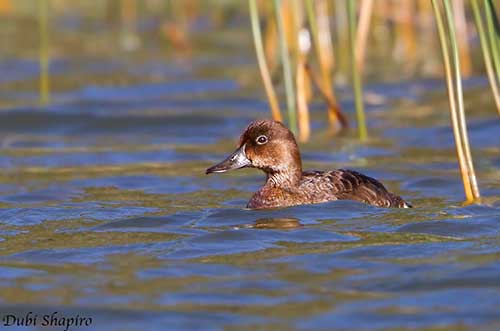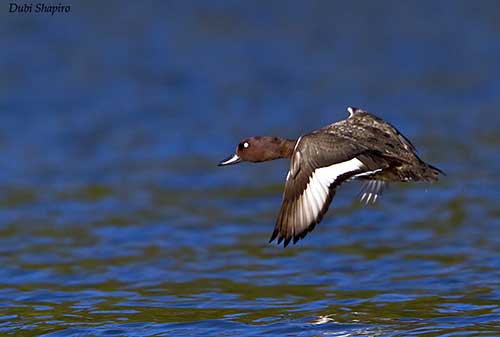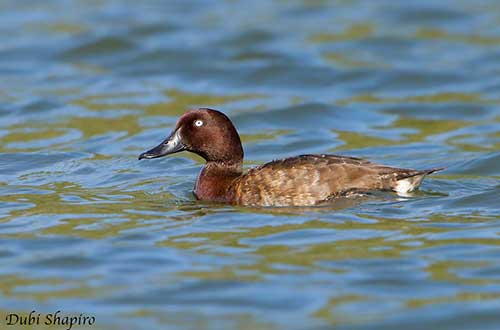
Fr: Fuligule de Madagascar
Ang: Madagascan Pochard
All: Madagaskarmoorente
Esp: Porrón Malgache
Ita: Moretta del Madagascar
Nd: Madagaskarwitoogeend
Sd: madagaskarbrunand
Mal: Fotsy maso, Onjo
Photographer:
Dubi Shapiro
Dubi Shapiro Photo Galleries & Dubi Shapiro's Pictures on IBC
Text by Nicole Bouglouan
Sources :
HANDBOOK OF THE BIRDS OF THE WORLD vol 1 by Josep del Hoyo-Andrew Elliot-Jordi Sargatal - Lynx Edicions - ISBN: 8487334105
GUIDE DES CANARDS, DES OIES ET DES CYGNES – de Steve Madge - Delachaux et Niestlé - ISBN: 2603013769
The Birds of Africa: Volume VIII: The Malagasy Region: Madagascar, Seychelles, Comoros, Mascarenes - Par Roger Safford, Frank Hawkins – ISBN: 1408190494, 9781408190494- Editeur: A&C Black, 2013
Birds of Madagascar and the Indian Ocean Islands Par Roger Safford, Adrian Skerrett, Frank Hawkins – ISBN: 1472924118, 9781472924117- Editeur: Bloomsbury Publishing, 2015
How to see Madagascar Pochard Aythya innotata, the world’s rarest duck
Rediscovery of the Madagascar Pochard Aythya innotata in northern Madagascar
Madagascar pochard, world's rarest bird, needs new home
World's rarest ducklings Madagascan pochards hatch
World's rarest duck on the rebound in Madagascar
The Struggle for Survival of the Madagascan Pochard - December 2014, Volume 12-6
Wikipedia, the free encyclopaedia
Madagascan Pochard
Aythya innotata
Anseriformes Order – Anatidae Family
INTRODUCTION:
The Madagascan Pochard is endemic to the island. It is very rare and was known only from a single location in the northern central plateau, at Lake Alaotra basin. This area and the wildlife living there have suffered from burning and hunting. This species and many other waterbirds disappeared from the lake. The last record from this location was in 1991.
But in late 2006, the Madagascan Pochard has been rediscovered by biologists from the Peregrine Fund in heavily forested lake situated 330 km N of Lake Alaotra. There were 9 adults and 4 juveniles. This lake was not suitable for rice cultivation because the water was cold and deep. It contained no fish. This suggests that this species may have survived at this site with little human disturbance.
Surveys in 2006 located 20 mature individuals and 9 ducklings at the same site. But 5 other ducks were seen at a second lake, 3-4 km from the previous site.
In spite of several breeding attempts between 2006 and 2012, only 21 adults were counted in 2012. Conservation efforts are underway, but the population is extremely small and the breeding success is very limited, probably due to lack of adequate food. The species is currently classified as Critically Endangered.

DESCRIPTION OF THE BIRD:
Biometrics:
Length: 45-46 cm
Weight: (of one male) 685 g
The Madagascan Pochard in breeding plumage has dark brown plumage. On the underparts, the breast is dark brown, flanks and vent are reddish-brown and belly and undertail-coverts are white.
Head and neck are brown with dark purplish wash.
The female is duller overall, but both sexes have white wingbar contrasting with the black tips of the flight-feathers.
The male in eclipse resembles female.
The bill is dark grey with black nail. The eyes are white (dark brown in female). Legs and webbed feet are grey.
The juvenile resembles adult but it is duller overall. The young male has pale grey eyes, becoming white during the first year.
RANGE:
The Madagascan Pochard was discovered in 2006 in the restricted area of Banemavka in NW Madagascar. The last record from the historical site Lake Alaotra (300 km to S) was in 1991. It is presumed to have once occurred throughout C Plateau from which the species disappeared after human colonisation and wetland degradation.

HABITAT:
The Madagascan Pochard frequents freshwater lakes, pools and swamps. It needs areas of open water and islets of vegetation.
This type of habitat was that of Lake Alaotra, but the rediscovery site, Lake Matsaborimena, is a deep volcanic lake and lacks emergent vegetation and fish.
CALLS AND SONGS: SOUNDS BY XENO-CANTO
The Madagascan Pochard is usually silent outside the breeding season. But during the displays, the male gives high, wheezy whirr and also higher whistles while throwing the head backwards.
The female utters soft, clucking “gek gek” and rasping “gak-gak-gak”.
BEHAVIOUR IN THE WILD:
The Madagascan Pochard appears to feed primarily on insects, and especially caddis fly larvae (Trichoptera). However, as it feeds principally by diving, it probably takes seeds and parts of aquatic plants. But more information is required.
It may remain underwater during 1-2 minutes.
The Madagascan Pochard is often seen alone, in pairs or in small groups of 3 individuals. The birds congregate on open water. Association with other duck species is not reported.
The breeding behaviour in the wild is unknown. However, from observations of captive birds, the displays are typical of the Order Anseriformes. Several males can be seen displaying around a single female with raised head and neck, or with the bill close to the water. Males throw the head backwards on to the back while giving high whistles.
The Madagascan Pochard is presumably sedentary, but some local movements between lakes probably occur.
The flight is fast and powerful when they fly length of lake.

REPRODUCTION OF THIS SPECIES:
The breeding season occurs between July and January. The Madagascan Pochard builds the nest in tuft of vegetation on bank, usually 10-20 cm above water level. It is made with pieces of marsh vegetation and lined with down feathers.
The female lays 6-10 buff-white eggs, and incubates alone during 26-28 days in captivity. The chicks are dark brown above and yellowish on face and underparts. The fledging success is very low with duckling mortality due to starvation, especially when 2-3 weeks old. This is probably due to lack of adequate food.
PROTECTION / THREATS / STATUS:
The Madagascan Pochard has a very small known population of less than 50 individuals and mature individuals, and no particular increase in numbers.
The young die by starvation due to absence of adequate food items and too deep water. Hunting and trapping, and increase of human population involving degradation of the habitat are important threats. Introduction of exotic plants, mammals (rats) and fish have destroyed the food supplies. Nest predation by rats and raptors also occurs regularly.
Conservation actions are underway, involving surveys at the site of rediscovery which is permanently guarded. The species breeds in captivity, in order to secure the existing population and to release another viable population in the wild. But restoration of the habitat is necessary.
Due to the tiny population still threatened by various factors, the Madagascan Pochard is currently classified as Critically Endangered.
